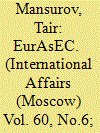|
|
|
Sort Order |
|
|
|
Items / Page
|
|
|
|
|
|
|
| Srl | Item |
| 1 |
ID:
138058


|
|
|
|
|
| Summary/Abstract |
INTEGRATION PROCESSES are a qualitatively new form of interaction between states in the modern world based on the establishment of a common framework for the operation of production factors and a single system for managing the common space, including a supranational component.The goals of integration are usually the same for all regional integration models, but in each particular case they have different motivations and are based on different approaches. The diversity of socio-economic, geographic, geopolitical, historical and cultural conditions generates numerous forms of integration, each of which is unique. The process of international integration as we know it today began in the mid-20th century, so that sufficient theoretical and practical experience has been gained throughout the world in this area.
|
|
|
|
|
|
|
|
|
|
|
|
|
|
|
|
| 2 |
ID:
127632


|
|
|
|
|
| Publication |
2013.
|
| Summary/Abstract |
Today, when democracy is in crisis, the developing countries are finding the stronger global and regional integration processes much more important than before. This is largely true of the post-Soviet countries which, having entered a new development stage, are coping with the globalization challenges through structural transformations. The Republic of Armenia is one of them.
Throughout the 25 years of its independence, Armenia has been consistently moving toward a free democratic society irrespective of numerous problems in all spheres, including its foreign policy sphere. Its national security problems are resolved by its military-strategic relations with Russia, which has formulated the idea of the EurAsEC as a common economic expanse to counterbalance the EU. Moscow is putting pressure on all the CIS countries (Armenia among them) in an effort to draw them into this new structure which, in the near future, is expected to develop into the Eurasian Union.
European integration is a foreign policy priority in Armenia. The European political establishment, in turn, is demonstrating a far from adequate approach, to say the least, toward Armenia's possible EurAsEC membership. The Europeans make no secret of their intention to put pressure on Armenia, not only to prevent its membership in the Eurasian Union, but also to weaken Russia's influence in the Southern Caucasus and fortify their own positions in the south of the post-Soviet space and the Middle East.
The far from simple choice between the EurAsEC and the EU is proving to be a durability test in complementarism.
|
|
|
|
|
|
|
|
|
|
|
|
|
|
|
|
| 3 |
ID:
144976


|
|
|
|
|
| Summary/Abstract |
TODAY, Russian-Chinese relations are officially described by Moscow and Beijing as a comprehensive, wide-ranging, equal and trusting partnership and strategic interaction (according to the Treaty of Good-Neighborliness and Friendly Cooperation between the People's Republic of China and the Russian Federation of July 16, 2001). Based on this geopolitical and geo-economic paradigm, effective and pragmatic practice has evolved, which has become a positive factor in global development and global governance in the 21st century.
|
|
|
|
|
|
|
|
|
|
|
|
|
|
|
|
|
|
|
|
|